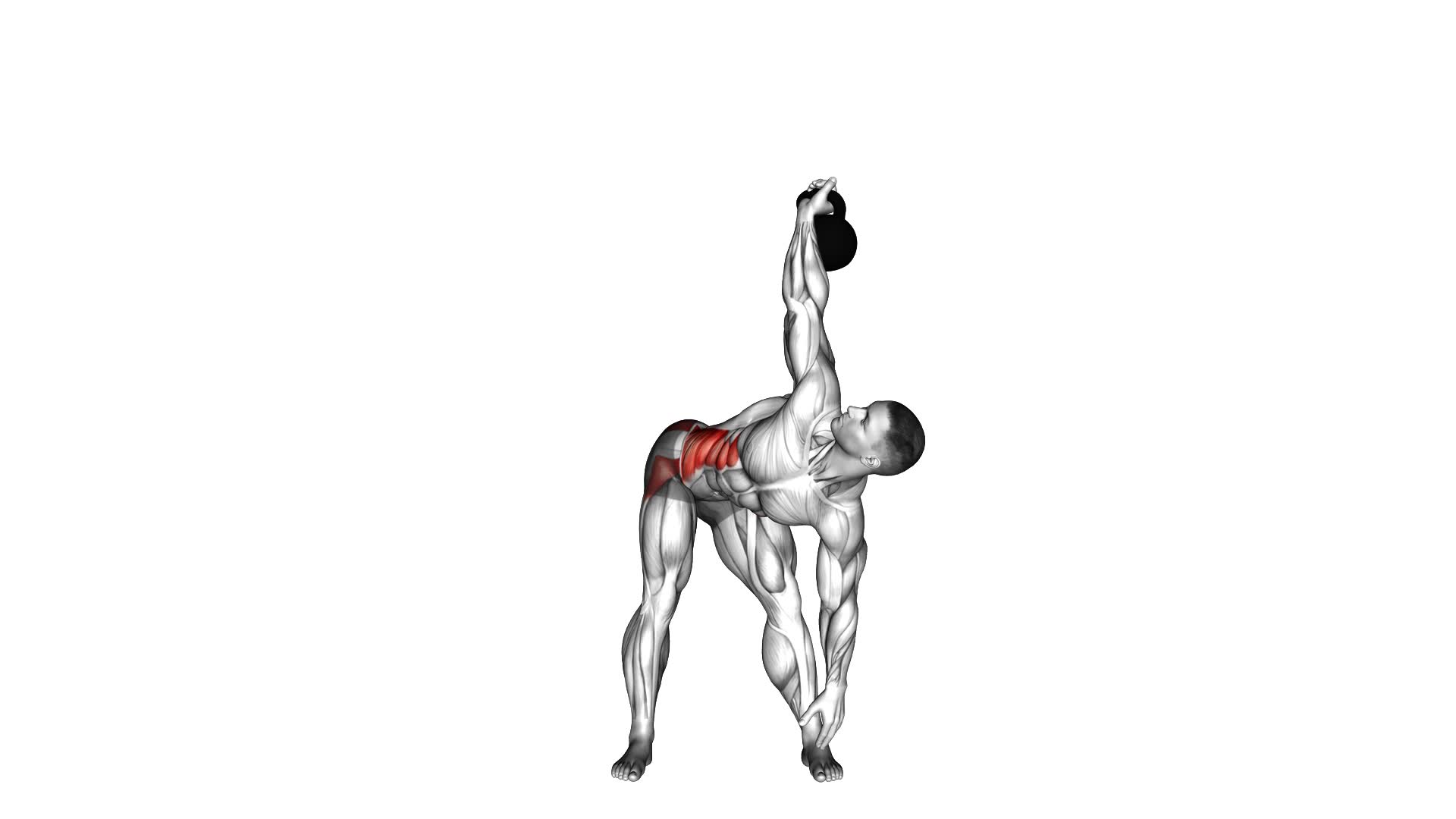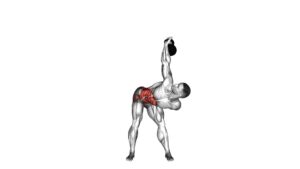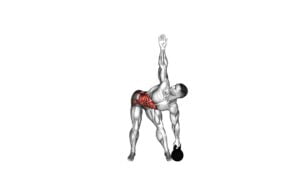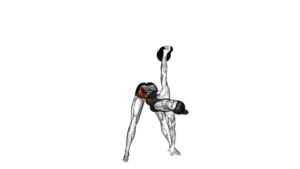Kettlebell Windmill – Video Exercise Guide & Tips

Are you looking to improve your core strength and flexibility?
Watch This Exercise Video
The Kettlebell Windmill is a fantastic exercise that targets your abs, obliques, and shoulders all at once.
In this video exercise guide, you will learn the proper technique for the Kettlebell Windmill, as well as common mistakes to avoid.
We will also cover variations and progressions to challenge yourself as you get stronger.
Get ready to incorporate the Kettlebell Windmill into your workout routine for maximum results.
Key Takeaways
- The Kettlebell Windmill strengthens core muscles, including abs and obliques.
- It improves posture and core stability.
- The exercise targets the shoulders and hips for improved stability and mobility.
- Incorporating variations and progressions of the Kettlebell Windmill can challenge strength and stability.
Benefits of the Kettlebell Windmill
The kettlebell windmill offers numerous benefits to help you improve your strength, flexibility, and core stability. By incorporating this exercise into your workout routine, you can expect to see improvements in these key areas.
One of the major benefits of the kettlebell windmill is its ability to strengthen your core muscles. As you perform the exercise, your obliques and lower back muscles are engaged, leading to increased core stability and improved posture.
In addition to core strength, the kettlebell windmill also targets your shoulders and hips. The exercise requires you to stabilize the kettlebell overhead while rotating through your hips, which helps to improve shoulder stability and hip mobility. This can be particularly beneficial for athletes or individuals who participate in activities that require rotational movements, such as golf or tennis.
Overall, the kettlebell windmill is a highly effective exercise that offers a wide range of benefits for your strength, flexibility, and core stability. By incorporating this exercise into your routine, you can enhance your overall fitness level and improve your performance in various physical activities.
Now, let's dive into the proper technique for the kettlebell windmill.
Proper Technique for the Kettlebell Windmill
To properly execute the kettlebell windmill, you'll need to maintain a strong core and engage your obliques and lower back muscles throughout the exercise. Here are three key elements to focus on for proper technique:
- Start by holding the kettlebell in your right hand, with your feet shoulder-width apart. Keep your right arm extended overhead, perpendicular to the ground.
- Begin the movement by shifting your weight onto your left foot, while simultaneously hinging at the hips and reaching your left hand down towards your left foot. Keep your eyes on the kettlebell throughout the exercise.
- As you lower your torso towards the ground, rotate your chest towards the ceiling, opening up your body. Your right arm should remain pointing straight up towards the sky.
Remember, proper form is crucial to prevent injury and maximize the effectiveness of the exercise. If you're new to the kettlebell windmill or have any physical limitations, it's important to consult with a fitness professional for kettlebell windmill modifications that suit your needs.
Common Mistakes to Avoid During the Kettlebell Windmill
When performing the kettlebell windmill, be mindful of the common mistakes to avoid. These mistakes can't only compromise your form but also increase the risk of injury.
One common mistake is failing to maintain a stable shoulder position throughout the movement. It's important to keep your shoulder packed and engaged to prevent any strain or discomfort.
Another mistake to avoid is allowing the kettlebell to drift away from your midline. This can cause imbalance and put unnecessary stress on your lower back. Instead, keep the kettlebell directly above your shoulder and aligned with your body.
Lastly, be cautious of not bending your knees enough during the descent. Proper form requires a deep knee bend to help maintain stability and engage your lower body.
By avoiding these common mistakes, you can perform the kettlebell windmill with proper form and reduce the risk of injury.
Now let's explore the variations and progressions of the kettlebell windmill.
Variations and Progressions of the Kettlebell Windmill
To progress your kettlebell windmill, you can incorporate variations that challenge your strength and stability. Here are three advanced variations and kettlebell windmill modifications that you can try:
- Single-arm kettlebell windmill: Instead of using two kettlebells, hold one kettlebell in one hand while keeping the other hand extended overhead. This variation increases the demand on your core and shoulder stability, making it more challenging.
- Bottom-up kettlebell windmill: In this variation, you hold the kettlebell upside down with the bell facing the ceiling. This requires even more stability and control as you navigate through the movement. It also increases the grip strength required to hold the kettlebell in place.
- Weighted kettlebell windmill: To add an extra challenge, you can hold a heavier kettlebell during the windmill exercise. By increasing the load, you'll further engage your muscles and enhance your overall strength.
Tips for Incorporating the Kettlebell Windmill Into Your Workout Routine
You can easily incorporate the kettlebell windmill into your workout routine for an effective full-body exercise. Adding kettlebell exercises to your training regimen has numerous benefits, such as improving strength, flexibility, and coordination.
To incorporate the kettlebell windmill into your workout routine, start by selecting an appropriate weight that challenges you without compromising form. Begin with a warm-up to prepare your body for the exercise.
Once you're ready, hold the kettlebell with one hand, keeping your arm extended overhead. Stand with your feet wider than shoulder-width apart, toes pointing outwards. Engage your core and slowly lower your torso towards the side while keeping your arm extended. Keep your eyes on the kettlebell throughout the movement. Pause when you reach your maximum range of motion, and then return to the starting position.
To maximize the benefits of the kettlebell windmill, aim for proper form and control rather than speed. Start with a lower weight and gradually increase as your strength and technique improve. Incorporate the kettlebell windmill into your routine 2-3 times per week, alternating with other exercises to target different muscle groups.
Remember to consult a fitness professional if you have any underlying medical conditions or are new to kettlebell training. With consistent practice and proper technique, the kettlebell windmill can be a valuable addition to your workout routine, helping you achieve your fitness goals.
Frequently Asked Questions
What Are the Different Muscles Targeted by the Kettlebell Windmill Exercise?
The kettlebell windmill exercise targets various muscle groups in your body, providing numerous benefits. By performing this exercise, you engage your core muscles, including your obliques and abdominals, to stabilize your body during the movement.
Additionally, it works your shoulders, specifically the deltoids, as well as your hips and hamstrings.
The kettlebell windmill can help improve your overall strength, stability, and flexibility while promoting core strength and posture.
Can the Kettlebell Windmill Be Modified for Individuals With Limited Mobility or Flexibility?
Yes, the kettlebell windmill can be modified for individuals with limited mobility or flexibility.
There are several modifications and adaptations that can be made to accommodate different needs.
These modifications may include using a lighter kettlebell, adjusting the range of motion, or incorporating additional support or props.
How Often Should the Kettlebell Windmill Be Performed for Optimal Results?
To get the best results from the kettlebell windmill, it's important to determine the frequency that works for you. Experiment with different schedules and listen to your body.
Some people find that performing the kettlebell windmill two to three times a week is sufficient, while others may benefit from more frequent sessions.
Additionally, varying the intensity and incorporating different kettlebell windmill variations can help keep your workouts challenging and effective.
Are There Any Specific Breathing Techniques to Follow During the Kettlebell Windmill Exercise?
When performing the kettlebell windmill exercise, it's important to focus on your breathing techniques. Proper breathing can help you maintain control and stability throughout the movement.
Take a deep breath in as you initiate the downward phase, exhale as you reach the bottom position, and inhale again as you come back up. This rhythmic breathing pattern will help you stay grounded and centered.
Additionally, modifications can be made for those with limited mobility or flexibility, allowing them to still benefit from this exercise.
Can the Kettlebell Windmill Help Improve Core Strength and Stability?
The kettlebell windmill is a fantastic exercise for improving balance, core strength, and stability. By incorporating this exercise into your routine, you can experience a variety of benefits.
Not only does it target your core muscles, but it also engages your shoulders, hips, and legs. This exercise requires proper form and technique, so be sure to follow a video exercise guide and tips to maximize its effectiveness.
Conclusion
In conclusion, the kettlebell windmill is a highly effective exercise for improving core strength, mobility, and stability. By following the proper technique and avoiding common mistakes, you can maximize the benefits of this exercise.
Additionally, there are variations and progressions available to challenge yourself as you become more proficient. Incorporating the kettlebell windmill into your workout routine will contribute to overall fitness and enhance your performance in various physical activities.

Author
Years ago, the spark of my life’s passion ignited in my mind the moment I stepped into the local gym for the first time. The inaugural bead of perspiration, the initial endeavor, the very first surge of endorphins, and a sense of pride that washed over me post-workout marked the beginning of my deep-seated interest in strength sports, fitness, and sports nutrition. This very curiosity blossomed rapidly into a profound fascination, propelling me to earn a Master’s degree in Physical Education from the Academy of Physical Education in Krakow, followed by a Sports Manager diploma from the Jagiellonian University. My journey of growth led me to gain more specialized qualifications, such as being a certified personal trainer with a focus on sports dietetics, a lifeguard, and an instructor for wellness and corrective gymnastics. Theoretical knowledge paired seamlessly with practical experience, reinforcing my belief that the transformation of individuals under my guidance was also a reflection of my personal growth. This belief holds true even today. Each day, I strive to push the boundaries and explore new realms. These realms gently elevate me to greater heights. The unique combination of passion for my field and the continuous quest for growth fuels my drive to break new ground.







